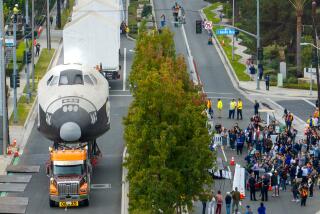Downey charts new frontier
- Share via
For half a century, life in Downey revolved around the 167-acre NASA site in the middle of town.
It was there, in airplane hangars erected on former bean fields, that the city’s men and women designed and built the spaceships that took the first Americans to the moon.
Then came 1999, when Boeing, which was operating the site at the time, moved its operations out of town.
The birthplace of the celebrated Apollo spacecraft and the space shuttle became “a gaping hole,” said Downey Mayor David Gafin.
“The paint was peeling, tumbleweeds were growing, asphalt was cracking,” he recalled recently.
Today, the site is home to the Columbia Memorial Space Center, a shiny new museum scheduled to open in late January that city leaders hope will allow the city to reclaim its piece of aerospace history and prove that it is getting back on its feet.
The museum’s directors say that it will be a learning center, aimed at teaching younger generations about Downey’s legacy and getting them excited about space.
In the nearly 10 years since Boeing left, the city has worked hard to redevelop the property. It now has a shopping complex, a new hospital and Downey Studios, a consortium of film production companies that shoot movies in the old warehouses.
It is also home to the Aerospace Legacy Foundation, an organization that played a big role in getting the new museum built. The foundation is headquartered in the former foundry, a windowless warehouse scattered with model spaceships, old maps and photographs.
Jerry Blackburn, the foundation’s president, said he holds on to these artifacts because he worries that the site’s history is being forgotten.
“A lot of the old-timers remember what went on here, but a lot of the children don’t understand the significance,” said Blackburn, who worked as an engineer at the site for more than 40 years. “It’s got a tremendous legacy and history. We need to nurture it and share it.”
Downey, in southeastern L.A. County, was mostly fields in 1929, when an entrepreneur named E.M. Smith bought a plot and turned it into an airfield and manufacturing plant. As the aircraft industry grew, Downey grew with it. By the 1960s, some 30,000 people were working there, building planes and missiles for North American Aviation, the contractor then operating the site.
NASA acquired the land in the early 1960s, and as the United States rushed to be the first country to send men to the moon, it turned to North American Aviation to develop the spacecraft to take them there. Engineers and other skilled workers moved to town. Subdivisions blossomed. People brimmed with patriotism.
“I would introduce myself and say, ‘I work over at the spaceship factory.’ And people would just get so excited,” Blackburn says. “You would go home in the evening and you would talk to your children and they were just in awe.”
In the late 1980s and early 1990s, North American Aviation, which had merged with Rockwell International Corp., was hit hard by cuts in military spending. By 1992, it had fewer than 5,000 employees. There was a glimmer of hope in town when Boeing North America acquired the company, but optimism faded in 1999, when Boeing moved its operations to Huntington Beach.
When the industry left Downey for good, the city was at a loss, said City Manager Gerald Caton. Real-estate values plummeted. Business at restaurants and the local mall fell, as did the city’s sales tax revenue. But it was more than just an economic depression, said Caton, whose father worked at the site for 27 years.
“The city was really saddened,” he said. “The city’s claim to fame ended when it closed down in 1999.”
Caton hopes the new museum will help the city re-stake that claim.
The gleaming metal building, which looks a little like a spaceship itself, will be home to a number of hands-on exhibits, including a robotics lab and a space flight simulator. It will be the official national memorial to the crew of the space shuttle Columbia, which broke apart on reentry in 2003, killing all seven on board.
It also will be a tribute to the industry that flourished in Downey.
“We can memorialize what happened on the site, but at the same time we can get a lot of school-age kids in there and get them excited about science,” Caton said. “It’s a way of remembering.”
--
More to Read
Inside the business of entertainment
The Wide Shot brings you news, analysis and insights on everything from streaming wars to production — and what it all means for the future.
You may occasionally receive promotional content from the Los Angeles Times.











